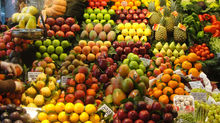Why and How to Choose Organic

"Organic" refers to a method of farming used to grow and process agricultural products like fruits, vegetables, grains, dairy products, and meat. Organic farming excludes conventional methods of fertilization and pesticides for weed control. Organic farmers use natural fertilizers to feed soil and plants and use crop rotation or mulch to manage weeds. In addition, organic farming is a more sustainable option since it’s designed to encourage soil and water conservation and reduce pollution.
Why choose organic?
Pesticides- Conventional farmers use synthetic pesticides to protect crops from molds, insects, and diseases. However, residue from these pesticides can remain of produce. Buying organic produce reduces exposure to pesticide residue.
Micronutrient levels- Recent research suggest levels of micronutrients are higher in organically produced foods than conventionally produced foods.
Artificial additives- Conventional foods often use fortifying agents such as preservatives, artificial sweeteners, colorings and flavorings, and monosodium glutamate. Organic regulations ban or severely restrict the use of these additives.
Environment- Organic farming is a more sustainable way of farming by reducing pollution and conserving water.
Identifying organic foods
The USDA has established an organic certification program requiring organic foods to meet strict government standards. These standards regulate how much food is grown, handled, and processed. Products certified 95% or more organic hold a USDA Organic seal. The packaging term “all natural” does not imply the foods is also organic. These two terms are not interchangeable.
Buying Organic Produce
Purchasing foods that are all organic can be inconvenient and expensive. Luckily, not all foods are produced with the same volume of pesticides. There are certain produce items with high pesticide content that should be purchased organic as often as possible. There are also produce items traditionally grown with a lower amount of pesticides. These should be chosen when an organic option is not available.
The Environmental Working Group (EWG) releases a list of foods with the highest and lowest pesticides each year. The following are EWG's lists for 2015.
EWG's 2015 Dirty Dozen - High pesticide fruits and veggies:
apples
celery
cherry tomatoes
cucumbers
grapes
nectarines
peaches
potatoes
snap peas
spinach
strawberries
sweet bell peppers
Other high pesticide foods not listed in the Dirty Dozen:
hot peppers, kale, collard greens, apricots, artichokes, cantaloupe from Mexico, cherries, pears, raspberries
EWG's 2015 Clean Fifteen - Lower in pesticide fruits and veggies:
asparagus
avocados
cabbage
cantaloupe
cauliflower
eggplant
grapefruit
kiwi
mango
onions
papaya
pineapple
sweet corn
sweet peas (frozen)
sweet potato
Other clean foods not listed in Clean Fifteen:
bananas, blackberries, blueberries, broccoli, brussel sprouts, carrots, chard, corn,
lettuce, okra, papaya, peaches (canned), peas, radishes, tangerines, tomatoes, watermelon
References
Mayo Clinic Staff. "Organic Foods: Are They Safer? More Nutritious?" Mayoclinic.com. N.p., n.d. Web. 24 Apr. 2015.
Hunter, D., M. Foster, JO McArthur, R. Ohja, P. Petocz, and S. Samman. "Evaluation of the Micronutrient Composition of Plant Foods Produced by Organic and Conventional Agricultural Methods." Taylor & Francis. Critical Reviews in Food Science and Nutrition, n.d. Web. 24 Apr. 2015.
Environmental Working Group Website: www.ewg.org
%20.png)















